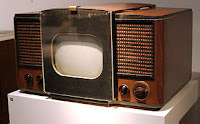Radio And Television
Radio and television were recognized as sources of education expansion when the rapid spread of radio in the United States in the 1930s led to proposals to use it for distance education. By 1938, at least 200 city school systems, 25 state boards of education, and many colleges and universities broadcast educational programs for the public schools.[ One line of thought was to use radio as a master teacher.
- " Experts in given fields broadcast lessons for pupils within the many schoolrooms of the public school system, asking questions, suggesting readings, making assignments, and conducting tests. This mechanizes education and leaves the local teacher only the tasks of preparing for the broadcast and keeping order in the classroom."
Radio and television had a typical setup in Kentucky in 1948 when John Wilkinson Taylor, president of the University of Louisville, teamed up with the National Broadcasting Corporation to use radio as a medium for distance education, The chairman of the Federal Communications Commission endorsed the project and predicted that the "college-by-radio" would put "American education 25 years ahead." The University was owned by the city, and local residents would pay the low tuition rates, receive their study materials in the mail, and listen by radio to live classroom discussions that were held on campus.
Radio and television: Charles Wedemeyer of the University of Wisconsin–Madison also promoted new methods. From 1964 to 1968, the Carnegie Foundation funded Wedemeyer's Articulated Instructional Media Project (AIM) which brought in a variety of communications technologies aimed at providing learning to an off-campus population. According to Moore's recounting, AIM impressed the UK which imported these ideas when establishing in 1969 The Open University, which initially relied on radio and television broadcasts for much of its delivery. Athabasca University, Canada's Open University, was created in 1970 and followed a similar, though independently developed, pattern.
The Open University inspired the creation of Spain's National University of Distance Education (1972) and Germany's FernUniversität in Hagen (1974). There are now many similar institutions around the world, often with the name "Open University" (in Englishor in the local language). All "open universities" use distance education technologies as delivery methodologies and some have grown to become 'mega-universities', a term coined to denote institutions with more than 100,000 students. In 1976, Bernard Luskin launched Coastline Community College as a college beyond walls, combining computer assisted instruction with telecourses proceed by KOCE TV, the Coast Community College District public television station. Coastline has been a landmark strategic success in helping to establish online distance learning using modern technology for learning
Radio and television as sources od distance learning, continue to play an important part in spreading education particularly in areas where elearning is still in its infancy.
 |
| Television |
 |
| Radio |
Comments
Post a Comment
We appreciate your comments! Please include your name and email address. Thanks!